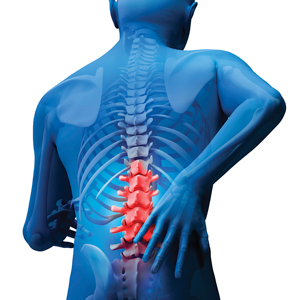 Imagine your back is like a fine watch with many moving parts. Your spine has 24 vertebrae attached to the pelvis at the bottom and the skull at the top. There are spongy discs between every two vertebrae, working as cushions. There are twelve sets of ribs, your breastbone (sternum), cartilage to stabilize your ribcage, and literally hundreds of ligaments holding everything together. Several large muscle groups move the bones and keep everything balanced.
Imagine your back is like a fine watch with many moving parts. Your spine has 24 vertebrae attached to the pelvis at the bottom and the skull at the top. There are spongy discs between every two vertebrae, working as cushions. There are twelve sets of ribs, your breastbone (sternum), cartilage to stabilize your ribcage, and literally hundreds of ligaments holding everything together. Several large muscle groups move the bones and keep everything balanced.
And if any of these parts decides to misbehave, you are at risk for developing back pain.
Poor posture is one of the major risk factors for back pain. Like that watch, the many small working parts of the back need to be functioning properly in perfect timing with the others. If posture is poor, increased strain is put on some of the parts; repetitive strain can lead to back pain.
Of course, good posture is important whether you’re sitting or standing. Your shoulders, ears, and hips should be lined up in a single line, perpendicular to the floor. Stuck sitting at your desk? Try to keep your hips slightly higher than your knees. Place a small pillow or a rolled towel behind your lower back if you will be sitting for long periods. Having said this, make an effort to reposition yourself every ten to 15 minutes. Lean back in your chair; pull your keyboard into your lap; and try to move anything below desk level that you routinely reach up for. This loading and unloading of the back reduces undue strain caused by leaning forward. When you are walking, flat shoes with cushioned soles will be most comfortable in helping to maintain good posture. If women feel like heels are called for at work, they should be worn sparingly.
Routine exercise and maintenance of the core, the layers of muscle surrounding the trunk, can help keep your back in shape. Like every muscle in the body, lack of exercise can result in weakness and reduced endurance. When this happens in your core muscles, it can affect your posture and reduce your spine’s resistance to injury.
Core muscles can be strengthened with exercises such as Pilates or yoga, and most cardiovascular workouts, like walking, swimming, and bicycling. However, if persistent back pain is already a part of your day, you might want to ask an experienced physical therapist or personal trainer for some recommendations.
Even the most serious desk jockey among us occasionally has to lift something, so it’s important to know how to lift safely. Your legs probably have the strongest muscles in your body. Take advantage of this strength when you’re lifting anything at work or at home. Bend at your knees, keep your back straight, and hold the weight as close to your body as you can. Don’t twist your body, because this loss of alignment can result in injury.
Proper nutrition is also important for maintaining spine health. Bone strength – remember all of those moving parts – requires dietary calcium and vitamin D. Most people are able to get enough of these essential vitamins from a balanced diet, but it’s a good idea to review your diet with your physician or with a nutritionist, and to use supplements if necessary.
If you’re carrying around extra pounds, you probably already know that being overweight can throw off your posture, starting a cascade of problems that can contribute to back pain.
Smoking may also contribute to degenerative changes in your spine. How so? To simplify it, cells are constantly turning over, with older cells being replaced by younger ones. This vital process requires oxygen and nutrients for your bones, muscles, tendons, and ligaments—the moving parts of your back. The use of nicotine results in reduced blood flow by causing the blood vessels to narrow or constrict, reducing the access to the important building blocks for maintenance.
To ward off back pain or have a decent chance at halting the discomfort that may have already started, you don’t have to train to run a marathon or take a daily yoga class. You do need to make smart lifestyle choices. Develop sensible eating habits, exercise moderately, and foster an awareness of how your back should be treated.
If the back pain you’re experiencing cannot be characterized as mild, steps can be taken to reduce problems. More significant back pain due to more significant causes can often be relieved with nonsurgical treatment, but your physician is the best person to guide your diagnosis and treatment.



